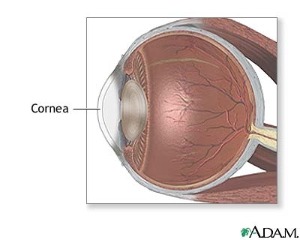|
What should you expect from a Contact Lens Exam?
A Contact Lens Exam is based on the findings of a comprehensive Eye Exam. In order to view the content, you must install the Adobe Flash Player. Please click here to get started.
The Patient History for a Contact Lens Exam will include questions that will help your eye doctor choose an appropriate lens material for you, whether Soft Disposable or
Rigid Gas Permeable.
Some of the questions your eye doctor may ask include: Examples of refractive errors include:
Your eye doctor will look at your Keratometry readings in order to determine the flatness or steepness of your corneal curvature. 
Because Contact Lenses must be fit according to your Corneal curvature, a Contact Lens Exam is a separate part of your routine Eye Exam. Remember that a Contact Lens is a controlled medical device that is placed on living tissue (i.e., your Cornea). For this reason, the relationship between your eyes and the Contact Lenses is dynamic as opposed to the static situation of wearing spectacles. For example, Toric Soft Contact Lenses are weighted to sit on a particular position on your eye in order to match your Astigmatism. However, factors such as the lid interaction with the Contact Lens, your blinking action, and the tear film layer between your Cornea and the Contact Lens, are all going to affect the stability of the fit and therefore the clarity of your vision. If a specific design of a Contact Lens is particularly unstable on your eye, your eye doctor will first try to adjust the prescription to compensate for the movement of the Contact Lens on your eye and then will change the lens brand in hopes that the new design will be more stable. As you can see, Contact Lens fittings are not only scientific and based on numbers, but there is a certain aspect of trial and error because of the dynamic environment that Contact Lenses must reside. Because adjustments may be necessary from time to time, a Contact Lens Exam by a licensed eye care provider must happen and must include you wearing the lenses to be prescribed so that your eye doctor can check your vision through the lenses and assess the fit. Some of the aspects of a fit that your eye doctor is looking for are: A Contact Lens Exam is necessary for all lenses that are prescribed. If you get a prescription for a clear Soft Contact Lens that is unavailable in color, you must return to your eye doctor to get a fitting for Color Contact Lenses, if you want this type. As you can see, an eyeglass prescription does not require any follow up care (unless you have trouble adapting to the new prescription). But a Contact Lens Exam requires your eye doctor to assess the lens he or she is prescribing on each eye in order to make sure that the fit and vision are adequate. Also, you should try the Contact Lens for 1-2 weeks before you buy them to make sure your vision is good and the fit is comfortable. |




